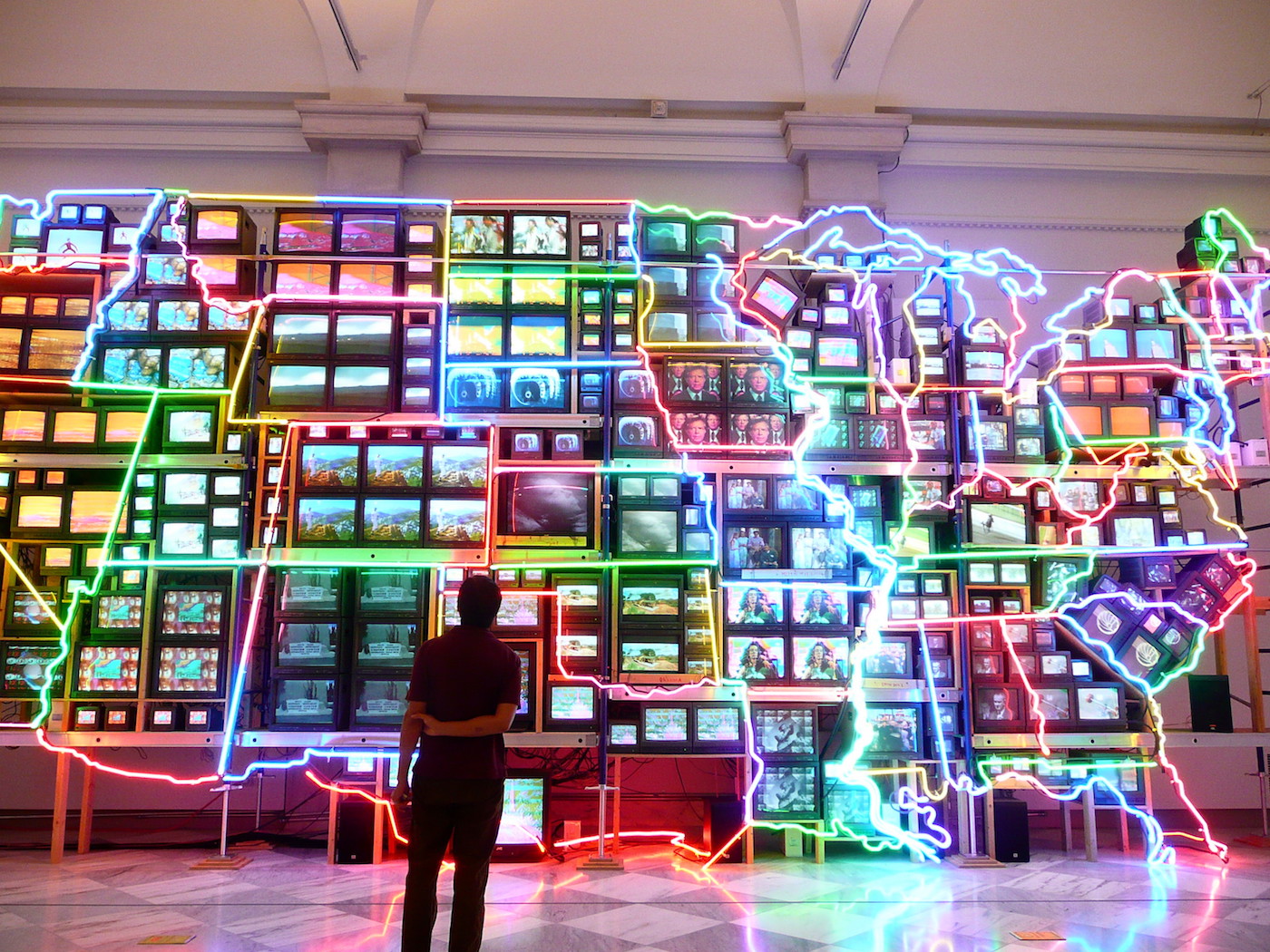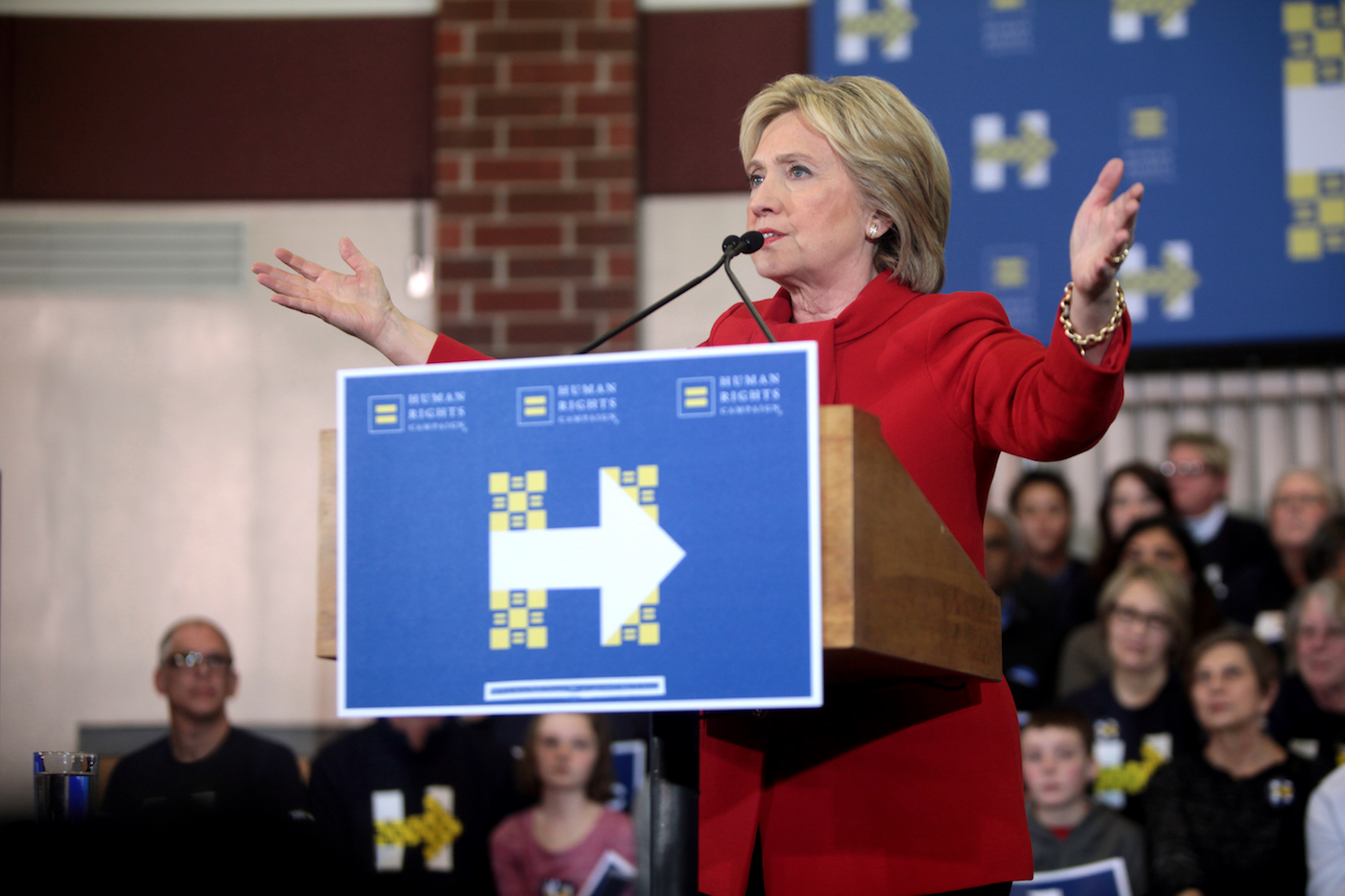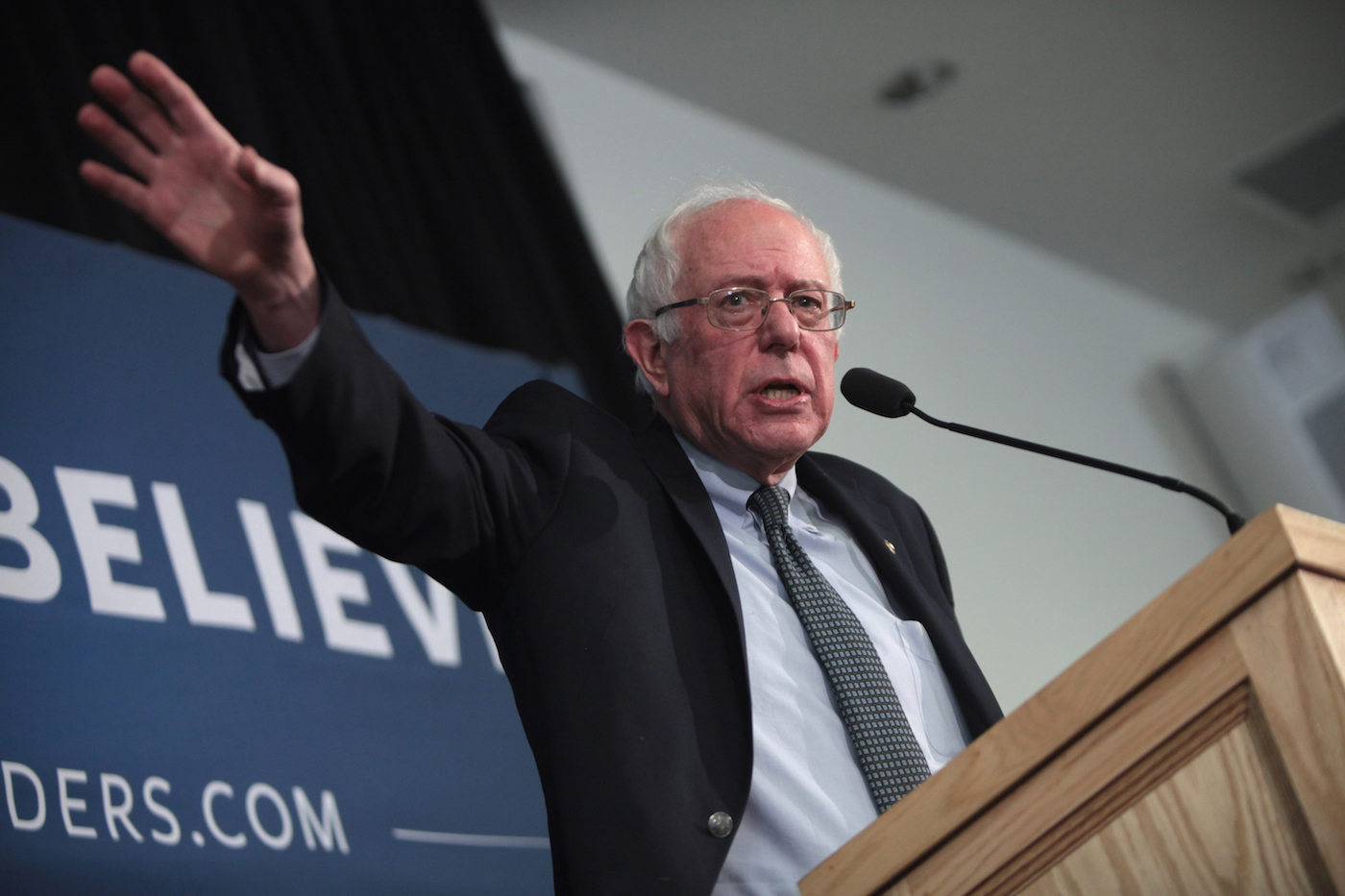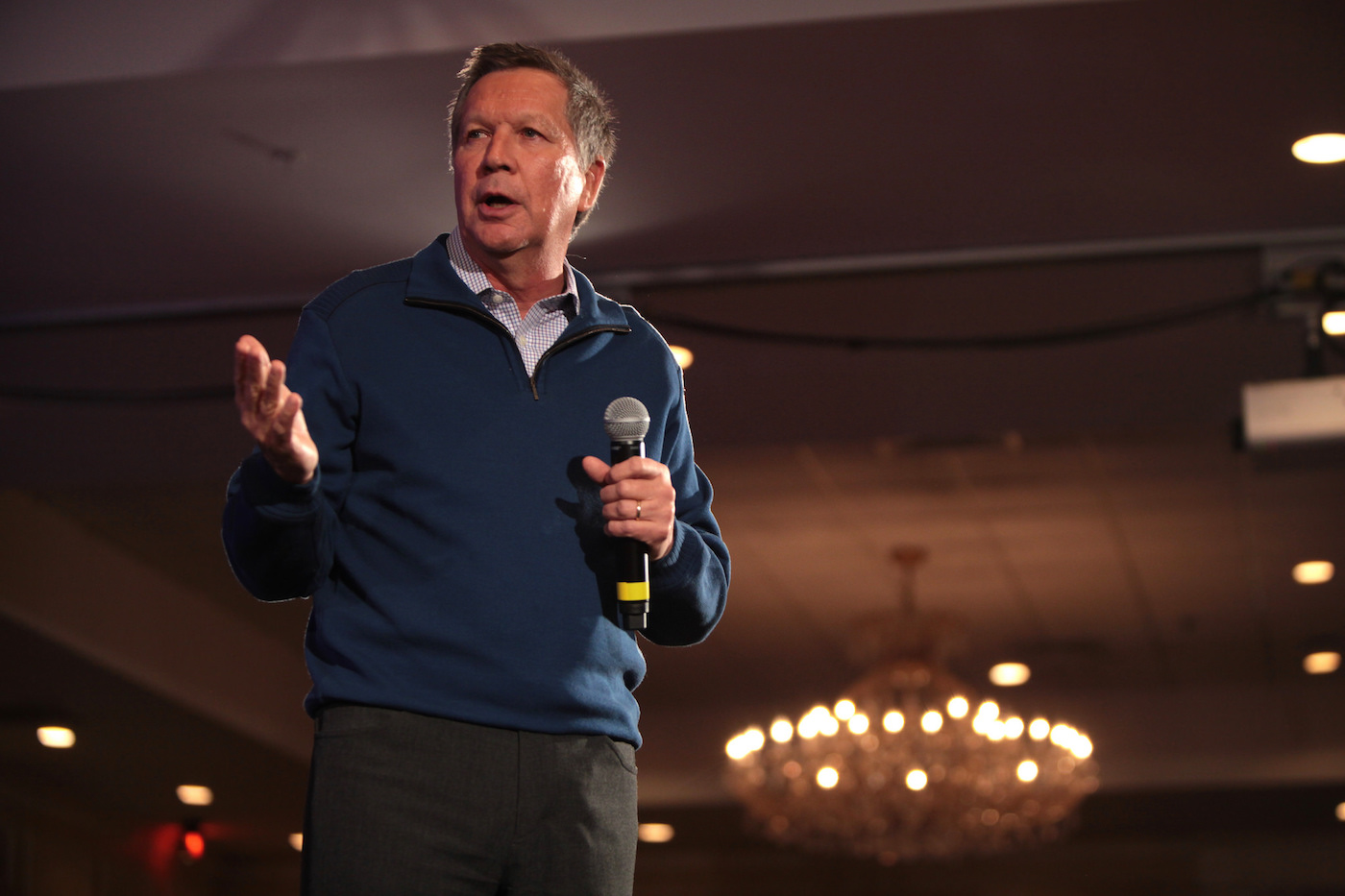
Nam
June Paik, “Electronic Superhighway: Continental U.S., Alaska, Hawaii”
(1995) (© Nam June Paik Estate, Smithsonian American Art Museum, photo
by angela n./Flickr)
The choice in November’s general election will no doubt be much clearer when it comes to support for arts, but the current field of two Democrats and three Republicans offers a rainbow of cultural policies. Here’s a rundown of some of the key points from each candidate’s political career.
DEMOCRATS
Hillary Clinton

Hillary Clinton speaking in West Des Moines, Iowa, on January 24, 2016 (photo by Gage Skidmore via Wikimedia Commons)
- In high school, Clinton (née Rodham) focused mostly on politics, but took time out to co-chair the Student Council Anti-Vandalism Committee. It’s uncertain what this means for her position on street art and graffiti.
- Her first date with Bill was a trip to the Yale Art Gallery to see a Mark Rothko exhibit — which would be great if it hadn’t involved crossing a picket line. She also spent a chunk of the visit sitting on a Henry Moore sculpture.
- In 1994, Bill Clinton signed into law “Goals 2000: The Educate America Act,” which set the first national standards for arts education. As then First Lady, Hillary was a strong advocate for the legislation and the importance of arts education overall.
- That same year, First Lady Clinton inaugurated the rotating White House Sculpture Garden and assembled the permanent White House Crafts Collection.
- In 1995, First Lady Clinton wrote an op-ed in the New York Times defending public funding for culture, specifically the National Endowment for the Arts (NEA):
This is an ominous time for those of us who care deeply about the arts in America. A misguided, misinformed effort to eliminate public support for the arts not only threatens irrevocable damage to our cultural institutions but also to our sense of ourselves and what we stand for as a people.
One of the great successes of the arts in America is that they are not the preserve of any “cultural elite.” Through museums, libraries, schools, dance companies and concerts, the arts are truly part of the public domain, accessible to all and capable of encouraging every person’s artistic expression and sensibility.
- In 1997, she criticized Republican attempts to reduce the NEA budget from $99.5 million to $10 million, calling the figure “totally inadequate if not embarrassing.”
- That same year, First Lady Clinton served as honorary chairwoman of a President’s Committee on the Arts and Humanities, which issued a 35-page report recommending “a ‘millennium initiative’ to revitalize public and private support for culture,” including “an appropriation by 2000 of $2 per citizen to support the national endowments for the arts and humanities, and for libraries and museums.” In her speech at the presentation of the report, she predicted Google Art Project, saying:
And as we prepare for a new century — and a new millennium — the arts and humanities are more essential than ever to the endurance of our democratic values of tolerance, pluralism and freedom. … And we can support efforts to ensure that America’s cultural resources are made more widely available on the Internet — so that a child growing up in some of our most isolated communities can take a virtual tour of our finest museums and libraries.
- Also that same year, First Lady Clinton won a Grammy: Best Spoken Word Or Non-Musical Album for the audio version of her children’s book It Takes a Village.
- In 1998, First Lady Clinton helped inaugurate Save America’s Treasures, a federal program to preserve historically significant buildings, artworks, documents, and more. From 1999 to 2010, the program awarded over $315 millionto nearly 1,300 projects.
- In 1999, Clinton won the Americans for the Arts’ National Arts Award for Arts Advocacy for her work for her work as First Lady.
- Between 2001 and 2007, then Senator Clinton co-sponsored a number of bills establishing a National Museum of African American History and Culture, a National Women’s History Museum, and a National Museum of the American Latino Community.
- In 2004, Senator Clinton co-sponsored S.287, the Artist-Museum Partnership Act, which would have changed the Internal Revenue Code to allow artists “a fair market value … deduction for charitable contributions of literary, musical, artistic, scholarly compositions, or the copyright.”
- In 2006, Senator Clinton was a member of the newly formed Senate Cultural Caucus.
- In 2013, then Secretary of State Clinton — along with the heads of a dozen government agencies and organizations — signed the “Declaration of Learning,” an initiative to promote the use of historic artifacts as the bases for digital educational tools.
- That same year, Secretary of State Clinton wrote a short piece for Vanity Fair about the Art in Embassies program:
In fact, art is also a tool of diplomacy. It reaches beyond governments, past the conference rooms and presidential palaces, to help us connect with more people in more places. It is a universal language in our search for common ground, an expression of our shared humanity.
- On the campaign trail, Clinton has said little about the arts, but she has reiterated her support for arts education.
Bernie Sanders

Bernie Sanders speaking at an event in Hooksett, New Hampshire, on January 21, 2016 (photo by Gage Skidmore, via Wikimedia Commons)
- In the late 1960s and ‘70s, while living in Vermont, a young Bernard Sanders wrote, produced, and sold “‘radical film strips’ and other education materials to schools about people like Eugene Debs.”
- He also wrote for the alternative newspaper the Vermont Freeman, penning essays about cancer and gender roles (the latter begins, “A man goes home and masturbates his typical fantasy”).
- In 1981, Sanders became the mayor of Burlington, Vermont, and shortly thereafter established the city’s first Arts Council. “At that time, way back when, it was almost unheard of to have a municipally funded and supported effort to promote the arts,” he says.
- In the mid 1980s, after his reelection as mayor, Sanders revitalized the Burlington waterfront, working to make it “people-oriented” and largely publicly owned, with space for parkland, beaches, a science center, and more.
- In 1987, Sanders released an album, titled We Shall Overcome, that features him speaking the lyrics of protest songs, accompanied by a choir. (He did not win a Grammy for it.)
- Between 1993 and 2014, while serving in the US House of Representatives and the Senate, Sanders co-sponsored bills establishing the National Museum of African American History and Culture and studying the creation of a National Museum of Latino Heritage and a National Women’s History Museum, as well as resolution to honor the Hudson River School painters, among others.
- Between 2004 and 2014, Americans for the Arts’ Action Fund gave Sanders an A+ for his arts-related voting record in the House and Senate.
- In 2014 and 2015, Sanders organized concerts with choruses from several Vermont high schools to stress the importance of public funding for arts education.
- Sanders has supported the Walter Reed Healing Arts Partnership.
- According to Americans for the Arts, “Sanders is known to enjoy ‘populist art.’ He embodies the ‘can-do’ and self-reliant spirit of Vermont, and sees the arts as another citizen driven initiative fueled by this spirit. Sanders strongly believes in the arts’ ability to break down cultural barriers, and that art can be used for cultural diplomacy.”
- In 2015, more than 100 “artists, musicians, and cultural leaders of America” endorsed Sanders’s candidacy. Margaret Cho, Ron English, and Bonnie Raitt are among the signers.
- In 2015, Sanders released a video promising to be an “arts President” if elected. In it, he says:
You have my promise that as President, I will be an arts President. I will continue to advocate strongly for robust funding of the arts in our cities, schools and public spaces. Art is speech. Art is what life is about.
- In 2016, Sanders launched a nationally touring art exhibition, titled The Art of a Political Revolution, which was on view in New York this past weekend.
REPUBLICANS
Ted Cruz

Ted Cruz speaking at New England College on February 3, 2016 (photo by Michael Vadon, via Wikimedia Commons)
- In a 2011 debate at the Wedgewood Baptist Church in Fort Worth, Texas, Cruz said:
We need to get the federal government out of areas it doesn’t have the constitutional authority to do. We need to eliminate the department of education, we need to eliminate the department of commerce, we need to eliminate the National Endowment for the Arts. We need to eliminate the IRS and move to a flat tax or a fair tax.
- Cruz’s adviser on national security, Victoria Coates, is an art history scholar specializing in the Italian Renaissance. She previously served as a consulting curator at the Cleveland Museum of Art and recently published David’s Sling: A History of Democracy in Ten Works of Art.
- In February, Cruz’s campaign pulled merchandise designed by the street artist Sabo from its online store after being questioned about Cruz’s position on the artist’s many racist comments and calls for the assassination of President Barack Obama on social media.
John Kasich

John Kasich speaking in Nashua, New Hampshire, on January 21, 2016 (photo by Gage Skidmore/Flickr)
- In 1983 and then again in 1987, Kasich was a co-sponsor of bills to have the square dance designated as the US’ national folk dance.
- In 1996, then Congressman Kasich voted in favor of the 1996 Interior Appropriations Bill, which cut NEA funding by $62 million.
- In 1998, Congressman Kasich voted against a proposed amendment to HR 4193, which would have restored $93 million in NEA funding.
- During a speech at the 2012 Governor’s Awards for the Arts ceremony, Kasich said:
We did have a very tough budget time, and we’re not out of the woods yet. But we all felt that the arts are critical. I know that there were a lot of people surprised that Republicans in the House and the Senate and the Governor’s Office could actually provide a very strong level of funding for the arts … the most since 1986.
- In 2013, his wife, Karen W. Kasich, created the “Spotlight: Featured Artists at the Governor’s Residence” program, a rotating display of works by Ohio artists installed in the governor’s residence and adjoining gardens.
- In 2014, Kasich established the Capital Arts and Cultural Committee to allocate funding for cultural projects throughout the state.
- In December 2014, Kasich passed State Bill 84 into law, creating the post of Ohio Poet Laureate; previously it had been one of only six states without a poet laureate position.
- Ohio’s two-year state budget, passed last June by Kasich, included an unprecedented 27.5% increase in funding for the Ohio Arts Council.
- In his State of the State address on April 6, Kasich said:
We will also recommend expanding what’s been known as STEM education to all grade levels. Of course, we all know the letters in STEM stand for science, technology, engineering, and math. But personally I like to call it STEAM. STEAM education — to add a capital A for the arts. Any student who’s going to succeed later in life, including someone choosing a technical career, is going to need creative skills and know how to apply critical thinking. Those skills are best developed by exposure to the arts. Science, technology, engineering, math, and the arts. Arts community, did you ever think you’d see a conservative Republican ever say this? But we believe it. Because these are all essential for success in these 21st Century careers.
Donald Trump

Donald Trump speaking in Mesa, Arizona, on December 16, 2015 (photo by Gage Skidmore/Flickr)
- In 1980, while demolishing the Bonwit Teller Building on Fifth Avenue to make way for Trump Tower, Trump promised two 15-foot-tall panels featuring ornate Art Deco designs and figures from the older building’s façade to the Metropolitan Museum — on the condition that the cost of removing them wasn’t prohibitive. After determining that their removal would have cost $32,000 and delayed the project by a week and a half, Trump ordered his crew to destroy the panels with jackhammers.
- In November 1999, at the height of the controversy surrounding the Young British Artists exhibition Sensation at the Brooklyn Museum, Trump — who at the time was weighing a possible run for president — waded into the public hysteria over Chris Ofili’s painting “The Holy Virgin Mary” (1996). “As President, I would ensure that the National Endowment of the Arts stops funding of this sort,” Trump told the Daily News, apparently not realizing that the exhibition had not received any NEA funding. “It’s not art. It’s absolutely gross, degenerate stuff. It shouldn’t be funded by government.”
- In December 1999, during a visit to the Museum of Modern Art with New York Times journalist Herbert Muschamp, Trump mistook a Donald Judd sculpture for a table and threw his jacket and some binders onto it.
- In 2013, Trump was awarded the lease to the Old Post Office Building in Washington, DC, to redevelop it into a Trump International Hotel. As a result, several government agencies that had long called the building home — including the NEA, the National Endowment for the Humanities, and the President’s Committee on the Arts and Humanities — were forced to relocate.
- In response to a question about NEA funding, Trump told the Washington Post:
The Congress, as representatives of the people, make the determination as to what the spending priorities ought to be. I had the great fortune to receive a comprehensive liberal arts education from an Ivy League institution. What is most important is that we examine how one-size-fits-all approaches imposed by the federal government have corrupted the availability and efficacy of liberal arts education. Critical thinking skills, the ability to read, write and do basic math are still the keys to economic success. A holistic education that includes literature and the arts is just as critical to creating good citizens.
- In a subsequent question about hypothetically hosting arts and culture events at the White House as president, Trump told the Post:
First, there is no Constitutional obligation for the President to do what your question implies. That said, supporting and advocating for appreciation of the arts is important to an informed and aware society. As President, I would take on that role.

Δεν υπάρχουν σχόλια:
Δημοσίευση σχολίου